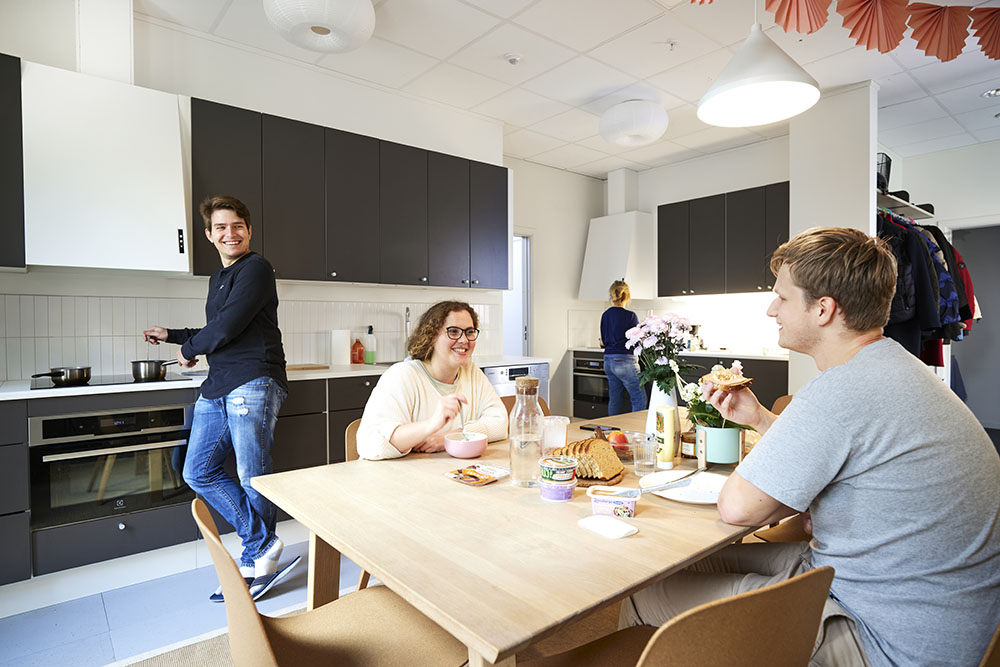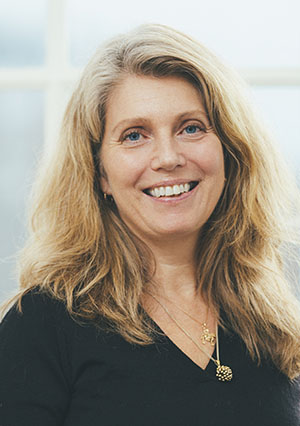Researchers experiment with future of sustainable student housing

A new, eco-friendly student residence project indicates that students in Sweden can expect a different kind of housing in the future.
For the last two years, researchers at KTH have been working with a design for student co-living, a concept that can lower climate footprint by an average of 35 percent, according to some studies. They are examining behavior and climate footprint for a full year in an experimental apartment unit which is currently shared by four students.

Design work on the unit, which is located in KTH’s Live-In Lab residence hall in the center of the Stockholm Campus, results from extensive interviews and seminars with students. The unit is now in its second design since the beginning of the research project, which is called Co-kitchen .
“Shared housing is a very good way to live, both socially, ecologically and economically,” says Sara Ilstedt , professor at KTH and project manager for Co-kitchen. “But there are norms, building regulations and traditions that make it better to build single resident housing.
"We want to change that.”
Goal to add smart university housing
The background to this project is that Akademiska Hus, which is responsible for university campuses in Sweden, has a goal to build 5,700 new residence units nationwide to provide students and researchers accommodations that are as environmentally smart—and functional—as possible. The researchers at KTH are studying how students use different rooms in the residence as well as common areas. They are also analyzing how much electricity and hot water is used in apartments with one room and kitchen compared to the shared housing.
Ilstedt says that social aspects of living together, such as where conflicts arise and measures to reduce them, are also part of the study. The project has already shown that simple things like eating dinner together once a week and implementing ready-made cleaning routines make a big difference.
She says that above all, shared housing creates social relationships and community, which reduces loneliness—a growing problem among young people.

Student surveys indicate a desire for community, Ilstedt says. “Both apartment and corridor residents experience that today's housing units prevent them from socializing and meeting friends. Just over 40 percent state that they would like to do this more often than is the case today.”
Social living a priority for some
One of the apartment’s residents, Laura Müller, an Architecture and Lightning Design student from Germany, says the pandemic made her realize she wanted a shared apartment. “For me who has had online studies all day, it would be awful to live alone in a small apartment, in a country where you do not know anyone.
“It was a priority for me t0 have roommates.”
The design of the test apartment enables students to choose between private and social zones, depending on their needs.
The researchers also investigate how the unit can be planned to support the establishment of sustainable habits. And innovative solutions are tested that, for example, take into account several users in the kitchen.
“The building standards that exist today (in Sweden) are designed for one household per apartment. The kitchen standard is still based on one person cooking for their family. But when you live in a shared home, the kitchen needs to be able to function for several single households who cook different food at the same time,” Ilstedt says.
Calculations show that this shared housing provides just over 30 percent lower climate footprint, with a larger living space per person and a more efficient use of the building. An ordinary newly built student apartment in Stockholm is 20-25 square meters. In this shared housing, each student has 8 square meters of private bedroom and 62 square meters of common areas at their disposal—all on the same built area as four studio apartments of 21 square meters. This is made possible by removing corridors, merging kitchens and utilizing built-up space efficiently.
Co-kitchen is a collaboration between KTH, Akademiska Hus, the architectural firm Theory Into Practice and the service design agency Savvy Design Collaborative. The project is funded by the Swedish Energy Agency. This project contributes to achieving the following global Sustainable Development Goals within the UN Agenda 2030: 11. Sustainable cities and communities, 12. Responsible consumption and production, 13. Climate action, and 16. Peace, justice and strong institutions.
Peter Ardell
